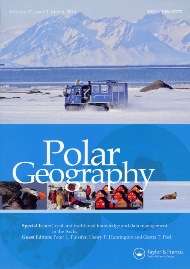Survey reveals the polarized public perceptions of the Polar regions

A fascinating new academic study suggests that peoples' political orientation affects their perceptions and knowledge regarding basic facts about the North and South Poles.
Writing in Polar Geography, Lawrence Hamilton, Senior Fellow at the Carsey School of Public Policy, University of New Hampshire, examines the results of a series of New Hampshire state surveys conducted from 2011 to 2015 that tracked public knowledge of some basic polar facts.
Hamilton's analysis indicates that these facts subjectively fall into two categories; those that are, and those that are not directly connected to people's beliefs about climate change.
Although there is a broad consensus among scientists on the reality of human-caused climate change, this idea remains politically disputed and divisive among US politicians and the public. Indeed, beliefs around climate change correlate so strongly with ideology that some analysts view both as indicators of the same thing.
Hamilton asked five key questions about the Poles. How would you respond?
- Which of the following three statements do you think is more accurate? Over the past few years, the ice on the Arctic Ocean in late summer – covers less area than it did 30 years ago; declined but then recovered to about the same area it had 30 years ago; or covers more area than it did 30 years ago.
- If the Arctic region becomes warmer in the future, do you think that will have – no effects on the weather where you live; minor effects on the weather where you live; or major effects on the weather where you live?
- Which of the following possible changes would, if it happened, do the most to raise sea levels? – melting of land ice in Greenland and the Antarctic; melting of glaciers in the Himalaya and Alaska; or melting of sea ice on the Arctic Ocean.
- Which of these best describes the North Pole? – ice a few feet or yards thick, floating over a deep ocean; ice more than a mile thick, over land; or a mainly rocky, mountainous landscape.
- Which of these best describes the South Pole? – ice a few feet or yards thick, floating over a deep ocean; ice more than a mile thick, over land; or a mainly rocky, mountainous landscape.
Responses to climate-linked factual questions, such as whether Arctic sea ice area has declined compared with 30 years ago, were politicized as if we were asking for climate-change opinions. Political divisions are less apparent with factual questions that do not infer climate change, such as whether the melting of Greenland and Antarctic land ice, or of Arctic sea ice, could potentially do the most to raise sea levels.
Only 30 percent of respondents answered the sea-level question correctly; Greenland and Antarctic land ice have much greater potential to raise sea level than Arctic sea ice, which is already floating on the ocean. Just 38 percent knew that the North Pole is on thin ice floating above a deep sea; an equal number thought it was on thick ice over land.
At odds with the low levels of factual knowledge, most respondents reported that they had a "moderate amount" or a "great deal" of understanding about climate change, where polar change has been a major area of interest.
A combination of low knowledge and high self-assessed understanding characterizes almost half of the sample, and correlates with political views. The low knowledge/high understanding combination is most prevalent among Tea Party supporters, where it reaches 61 percent. (Democrats, Independents and Republicans appear roughly similar at 41–47 percent). This pattern suggests that their sense of understanding about climate change more often has an ideological basis.
Hamilton concludes by noting that the varied combinations of self-confidence and knowledge found in these surveys suggest that different science-communication strategies are needed to reach different groups; simply providing more information is only likely to work for some people.
More information: "Polar facts in the age of polarization", Lawrence C. Hamilton, Polar Geography, 2015, Taylor & Francis Group, dx.doi.org/10.1080/1088937X.2015.1051158
Provided by Taylor & Francis
















